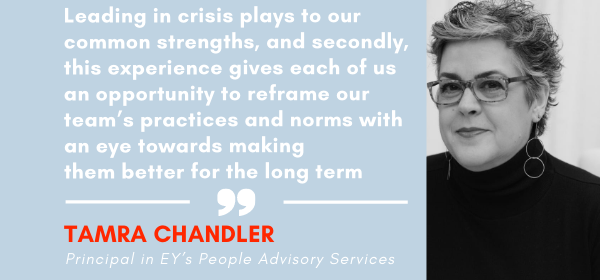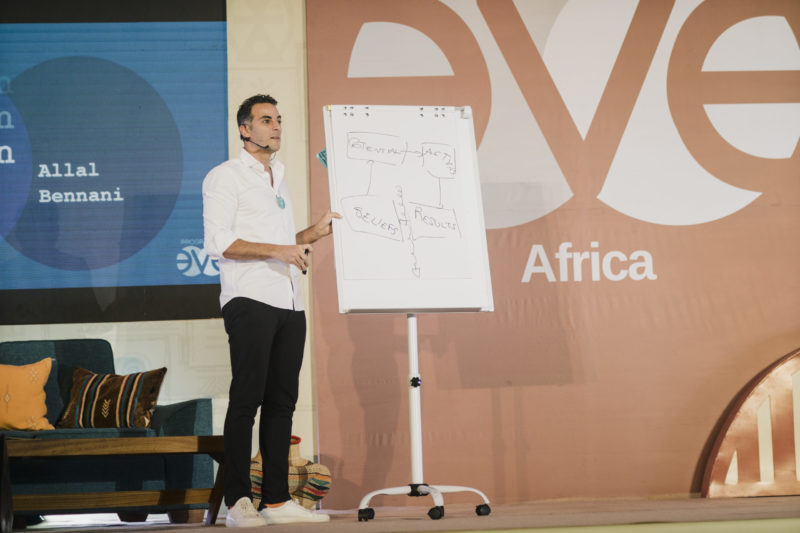Tamra Chandler for the EVE webmagazine
I think we’re all pretty clear on the bad news about the state of the world and the current risks and conditions we’re operating under. But here are a couple of morsels of good news for you women leaders out there: firstly, leading in crisis plays to our common strengths, and secondly, this experience gives each of us an opportunity to reframe our team’s practices and norms with an eye towards making them better for the long term. If I could offer you one piece of advice on leading your teams (and your families) at this time, it would be to focus on the long game, play to your strengths, and keep it human.
Considering the combined pressures of a global health crisis, civil unrest, and an economic free fall, it’s safe to say that nearly all of us are operating under some level of stress or worse, duress. When we humans are in an anxious state, we don’t behave or react as we normally would. Further, what we want and need from our jobs, bosses, and organizations shifts. If we leaders blithely forge ahead, pushing the same expectations, trying to operate under old norms, and avoiding the realities of the day, we are only aggravating the situation and further depleting our team’s energy.
As you consider how you might shift your leadership style and habits at this time, start with this question: What is important right now? This should lead you to considering outcomes like the following, as well as a few of your own:
- an authentic demonstration of trust
- frequent and meaningful connections with your people
- facilitating cross-team connections and sharing
- clarifying expectations and emphasizing an understanding of what’s important now
- coaching and support on how to successfully operate in the current environment given personalized realities (home schooling, isolation, etc.)
- recognizing progress — it’s unlikely that we can manage big or long-term goals today; instead, we need to celebrate and note the small successes and our forward movement
- providing opportunities for development and growth
Once you’ve gotten yourself on your leadership priorities, here are a few tips to help you deliver against them:
- Connect First!: Staying connected is vital to lowering stress and enhancing employee productivity, hence adopting a model of frequent check-ins is a proven way to increase connection and clarity and assure your people that they are truly valued in this time of uncertainty and fear. Research shows that the best conversations, even in tough times, build trust, and trust creates a positive cycle that can help us, our teams, and our organizations become stronger and more resilient.
- Focus on priorities: Priorities are a near-term, flexible, and fluid option to the classic goal. Priorities are a better fit for agile teams. They fuel more effective and frequent check-ins and support managers, employees, and teams in staying on course. Priorities set employees up for “small wins” and celebrate progress over perfection. Clarifying for employees where to focus (and what to let go) will not only optimize the value of their time and effort, but it will also lower their anxiety at this highly stressful time.
- Let go of old-school assessments: Considering an individual’s contributions and capabilities in our current reality should not be about ascribing a rating, ranking or assessment. What matters now is how people are showing up and what they are contributing. This requires organizations and leaders to first be clear on what is needed and expected, then to invest the time to coach employees and teams on how best to deliver on those expectations.
- Double down on development: Yes, our current predicament seems overwhelming. That doesn’t mean it should be an excuse for abandoning a commitment to development. Quite the opposite, in fact: This crisis has shifted strategic focus for nearly every enterprise. In addition to asking employees to address current needs and work, leaders also need to provide them with opportunities to experience something new, build skills and connect to what matters now.
- Lean into teams: We’re all in this together. So why not ensure that your approach to managing employee performance and growth reflects that sentiment? Consider shifting your focus to the collective energy of the team or enterprise. Individuals will bring the best they can give you today if you tune your actions to creating strong connections to their peers, team and your organization’s purpose.
- Trust the crowd and build a habit of recognition: Social distancing has positioned most managers as remote managers, maybe for the first time, and hence there is a need to lead differently. Our distance also highlights a reality that has always been true: No manager can see everything. Creating a culture of recognition increases the number of eyeballs looking for positive contributions to recognize and reward. And guess who witnesses all the great work and contributions within your organization? Your people! Empower them to celebrate the goodness they see around them through peer-based recognition and gratitude strategies.
 Tamra Chandler is a Principal in EY’s People Advisory Services with more than 30 years of experience guiding organizations towards the ultimate win-win: inspired people driving inspired performance. She has devoted her career to developing new methods of building aspirational cultures, aligning leaders and teams to compelling strategies, transforming organizational models, modernizing HR, and rethinking talent processes like performance management and feedback. A nationally recognized thought leader and speaker, Tamra has authored two books How Performance Management is Killing Performance – and What to Do About It (2016) and Feedback (and Other Dirty Words): Why We Fear It, How to Fix It (2019). She is known for her down-to-earth style, results-driven approach and focus on the human element of organizations.
Tamra Chandler is a Principal in EY’s People Advisory Services with more than 30 years of experience guiding organizations towards the ultimate win-win: inspired people driving inspired performance. She has devoted her career to developing new methods of building aspirational cultures, aligning leaders and teams to compelling strategies, transforming organizational models, modernizing HR, and rethinking talent processes like performance management and feedback. A nationally recognized thought leader and speaker, Tamra has authored two books How Performance Management is Killing Performance – and What to Do About It (2016) and Feedback (and Other Dirty Words): Why We Fear It, How to Fix It (2019). She is known for her down-to-earth style, results-driven approach and focus on the human element of organizations.






